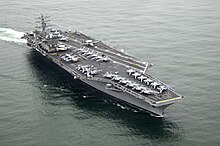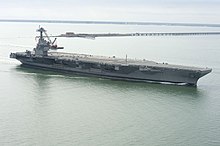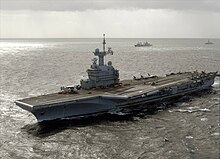avia.wikisort.org - Aircraft_carrier
CATOBAR ("Catapult Assisted Take-Off But Arrested Recovery" or "Catapult Assisted Take-Off Barrier Arrested Recovery") is a system used for the launch and recovery of aircraft from the deck of an aircraft carrier. Under this technique, aircraft launch using a catapult-assisted take-off and land on the ship (the recovery phase) using arrestor wires.


Although this system is costlier than alternative methods, it provides greater flexibility in carrier operations, since it imposes less onerous design elements on fixed wing aircraft than alternative methods of launch and recovery such as STOVL or STOBAR, allowing for a greater payload for more ordnance and/or fuel. CATOBAR can launch aircraft that lack a high thrust to weight ratio, including heavier non-fighter aircraft such as the E-2 Hawkeye and Grumman C-2 Greyhound.[1][2][3]
Types
The catapult system in use in modern CATOBAR carriers is the steam catapult. Its primary advantage is the amount of power and control it can provide. During World War II the US Navy used a hydraulic catapult.
The United States Navy is developing a system to launch carrier-based aircraft from catapults using a linear motor drive instead of steam, called the EMALS.
Current users
Only two states currently operate carriers that use the CATOBAR system following the decommissioning of Brazil's NAe São Paulo in February 2017; the U.S. with its Nimitz-class and Gerald R. Ford-class and France with its Charles De Gaulle.
U.S. Navy Gerald R. Ford-class carriers will use the EMALS electromagnetic aircraft launch system in place of steam catapults.[4]
Active CATOBAR aircraft carrier classes
| Class | Picture | Origin | No. of ships | Propulsion | Displacement | Operator | Aircraft carried | Catapult |
|---|---|---|---|---|---|---|---|---|
| Nimitz |  |
United States | 10 | Nuclear | 100,020 t (220,510,000 lb) |
United States Navy |
F/A-18C Hornet F/A-18E/F Super Hornet F-35C Lightning II EA-18G Growler C-2 Greyhound E-2C/D Hawkeye |
C-13-1 or C-13-2 steam |
| Gerald R. Ford |  |
United States | 1 | Nuclear | 100,000 t (220,000,000 lb) | United States Navy | F/A-18E/F Super Hornet F-35C Lightning II EA-18G Growler E-2D Hawkeye |
EMALS |
| Charles de Gaulle |  |
France | 1 | Nuclear | 42,500 t (93,700,000 lb) | French Navy | Rafale M E-2C Hawkeye |
C-13-3 steam |
CATOBAR carriers under construction
| Class | Picture | Origin | No. of ships | Propulsion | Displacement | Operator | Aircraft carried | Catapult |
|---|---|---|---|---|---|---|---|---|
| Gerald R. Ford |  |
United States | 2 | Nuclear | 100,000 t (220,000,000 lb) | United States Navy | F/A-18E/F Super Hornet F-35C Lightning II E-2D Hawkeye |
EMALS |
| Fujian (Type 003) |
 |
China | 1 | Conventional | 80,000+ t |
People's Liberation Army Navy |
Shenyang J-15 Shenyang J-35 Xi'an KJ-600 Harbin Z-20 |
EM catapult[5] |
Potential users
The Chinese Fujian (Type 003), currently under construction at the Jiangnan Shipyard, will feature an integrated electric propulsion system that will allow the operation of electromagnetic catapults, similar to the Electromagnetic Aircraft Launch System (EMALS) used by the United States Navy.[6][7]
INS Vishal, India's second indigenous aircraft carrier of the Vikrant-class, is planned to be of 65,000 ton displacement and to utilize the EMALS catapults developed by General Atomics, as it supports heavier fighters, AEW aircraft and UCAVs that cannot launch using a STOBAR ski jump ramps.[8]
See also
References
- "How Effective Will China's Carrier-Based Fighters Be?". Archived from the original on 2012-04-27. Retrieved 2017-08-15.
- "US-India Collaboration on Aircraft Carriers: A Good Idea?". Archived from the original on 2015-05-19. Retrieved 2021-02-12.
- "Indian Navy seeks EMALS system for second Vikrant-class aircraft carrier". 29 May 2013. Archived from the original on 2017-08-15. Retrieved 2015-01-08.
- "Gerald R Ford Class (CVN 78/79)". naval-technology.com. Archived from the original on 20 December 2013. Retrieved 15 January 2014.
- "新航母不用核动力就能电弹 靠这套领先全球的技术|航母_新浪军事_新浪网". mil.news.sina.com.cn. Archived from the original on 2022-01-15. Retrieved 2022-01-15.
- Minnie Chan (1 November 2017). "Breakthrough to Power most Advanced Jet Launch System on China's second Home-grown Aircraft Carrier". South China Morning Post. Archived from the original on 5 November 2017. Retrieved 1 January 2018.
- "China Claims to have Developed Conventionally Powered Electromagnetic Catapult" (archived copy ed.). Archived from the original on 2017-11-11. Retrieved 2018-01-01.
- "Indian Navy seeks EMALS system for second Vikrant-class aircraft carrier". 29 May 2013. Archived from the original on 2017-08-15. Retrieved 2015-01-08.
На других языках
- [en] CATOBAR
[fr] CATOBAR
CATOBAR (acronyme de l'anglais Catapult Assisted Take-Off But (ou Barrier) Arrested Recovery) est un système utilisé pour le catapultage et l'appontage d'aéronefs sur un porte-avions. Avec cette technique, l'avion est projeté à grande vitesse grâce à une catapulte et atterrit (phase de récupération) en se servant de brins d'arrêt présents sur le pont.[it] CATOBAR
CATOBAR (Catapult Assisted Take Off Barrier Arrested Recovery - «Decollo assistito da catapulta recupero con cavi di arresto») è un sistema utilizzato per il lancio e il recupero di un aereo dal ponte di una portaerei. Con questa tecnica, l'aereo decolla utilizzando una catapulta per aerei e apponta (fase di recupero) con i cavi d'arresto. Benché questo metodo sia più costoso rispetto ad altri alternativi, dà una maggiore flessibilità nelle operazioni delle portaerei, perché consente alla nave di portare aerei convenzionali. Con altri metodi di lancio si possono utilizzare infatti solo velivoli STOVL o VTOL.Другой контент может иметь иную лицензию. Перед использованием материалов сайта WikiSort.org внимательно изучите правила лицензирования конкретных элементов наполнения сайта.
WikiSort.org - проект по пересортировке и дополнению контента Википедии